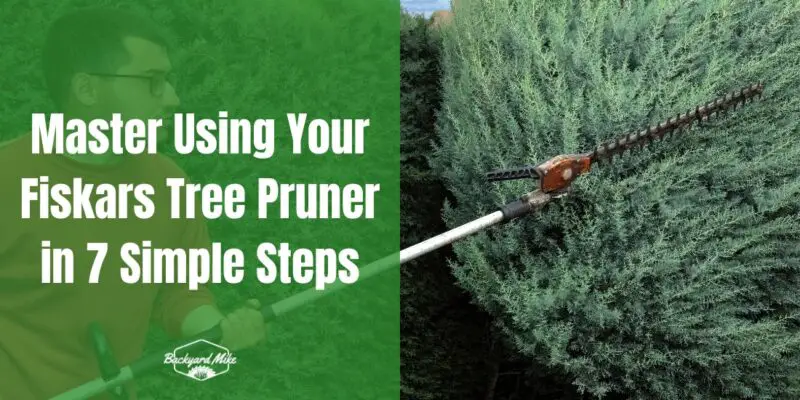To master your Fiskars tree pruner, understand its components: the pulley system, telescoping handle, and saw option. Set it up by extending both sections evenly. Identify the branches to prune, focusing on dead or crowded ones. Adjust the height for ideal leverage, and use the pulley for efficient cutting. Switch to the saw for thicker branches. Prioritize safety with gear and a stable stance. To further improve, explore detailed insights and tips to enhance your pruning skills.
Key Takeaways
- Familiarize yourself with the pruner's components, such as the pulley system and telescoping handle, for efficient use.
- Regularly inspect and maintain the pruner, including lubricating parts, to ensure optimal performance and longevity.
- Practice safe techniques, like keeping fingers clear of cutting edges, to prevent accidents during operation.
- Identify ideal branches to prune, focusing on dead, broken, or crowded ones for tree health and structure.
- Communicate and collaborate with others, asking for assistance when necessary, to enhance safety and efficiency.
Understanding the Components of Your Fiskars Tree Pruner
To master your Fiskars Tree Pruner, it's vital to understand its components and how they work together for best performance.
First, take a look at the pulley system. This innovative feature allows you to efficiently cut branches by leveraging mechanical advantage, especially for lower branches.
Efficiently cut lower branches with the innovative pulley system's mechanical advantage.
Next, notice the telescoping handle. It extends over 16 feet, giving you access to high and hard-to-reach branches without the need for a ladder.
You'll also find a saw option, providing a versatile backup if the pulley system struggles.
Finally, keep in mind the sharp, dangerous cutting edges that demand careful handling.
Understanding these components guarantees you use your pruner safely and effectively, making you a valued part of the tree-care community. For those considering different tools, cordless electric pole saws are lightweight and portable, suitable for light to moderate trimming tasks.
Properly Setting Up the Pruner for Use
To begin setting up your Fiskars tree pruner, press the release button to open the telescope mechanism, granting you access to its impressive reach of over 16 feet. It's essential to extend both telescoping sections evenly for best stability and balance, which enhances your control during the pruning process. Consider using the pruner's rope-free design to further improve safety and ease of use during your gardening tasks.
Telescope Mechanism Release
When setting up your Fiskars tree pruner, you'll find that mastering the telescope mechanism release is essential for effective operation. Begin by pressing the designated button to smoothly release the telescope mechanism. Before extending, inspect the pruner for any obstructions that could hinder functionality—this is a critical maintenance technique. Practice adjusting the height by pressing and pulling down to guarantee ideal positioning. These telescope mechanism tips help prevent common issues, like misalignment or sticking. Once you've adjusted the pruner, double-check that both telescoping sections are fully extended and securely locked to guarantee stability. Regular maintenance, like ensuring your pruner is well-lubricated similar to automatic oiler feature, can prolong its lifespan and enhance performance. This attention to detail not only enhances your tool's efficiency but also fosters a sense of belonging among fellow enthusiasts who value precision and reliability.
Maximum Reach Extension
Achieving the maximum reach with your Fiskars tree pruner requires careful attention to its telescoping mechanism.
To release the maximum reach benefits, press the release button and gently pull the sections apart until they click securely into place. This telescoping advantage allows you to extend over 16 feet, boosting your pruning height efficiency and eliminating the need for a ladder.
Before you start, identify the branches to trim, guaranteeing your pruner's height is appropriately adjusted. Firmly press and pull down on the device, maintaining control to prevent sudden movements.
Always double-check the locks before cutting to verify safety. With these steps, you'll join a community of skilled gardeners who handle their tree pruning with precision and confidence.
Identifying the Right Branches to Prune
When you assess branch health, focus on spotting dead, diseased, or damaged limbs, as these are essential to remove for the tree's vitality.
Timing your pruning efforts is equally important; late winter or early spring is generally ideal because it reduces stress on the tree and promotes robust regrowth.
Branch Health Assessment
- Dead or broken branches – Remove to eliminate hazards.
- Crossing or rubbing branches – Prune to prevent wounds and pest entry.
- Crowded branches – Thin out to enhance air circulation and sunlight.
These steps guarantee your tree remains healthy and vibrant.
Optimal Pruning Timing
For many, the ideal pruning period is late winter or early spring, just before the tree bursts back into growth. This seasonal timing allows trees to heal efficiently and minimizes disease risk. Focus on pruning techniques that enhance tree health by removing dead, damaged, or diseased branches. Identify branches that cross or rub against each other, as these can cause decay.
| Pruning Task | Benefit |
|---|---|
| Remove dead branches | Prevents disease and pest invasion |
| Eliminate crossing branches | Reduces decay risk |
| Maintain tree structure | Guarantees balanced growth |
| Prune to healthy buds | Encourages directed new growth |
Consider the tree's structure; aim to improve air circulation and light penetration by thinning branches. Always prune back to a healthy bud or lateral branch to guide new growth effectively.
Adjusting the Pruner to the Desired Height
- Press and pull down while maintaining a secure grip to effectively adjust the height.
- Fully extend both sections for maximum reach, ensuring a stable connection.
- Regularly check for stability to guarantee safety during use.
Confirm your pruner is properly positioned before cutting.
Mastering these steps fosters a sense of community among fellow gardening enthusiasts, enhancing your overall pruning experience.
Utilizing the Pulley System for Efficient Cutting
When you're ready to tackle those high branches, understanding the intricacies of the pulley system in your Fiskars tree pruner will make the task much simpler and efficient.
Start by identifying the branch to cut, confirming it's within reach. Release the telescope mechanism, extending it over 16 feet. Position the saw directly above the branch for ideal leverage.
As you pull the cutting line smoothly, the pulley system mechanics engage, enhancing your cutting efficiency techniques. This approach allows the saw to glide through the branch without excessive force.
Branch thickness considerations are vital; if the system struggles, it indicates the branch might be too thick. This knowledge guarantees you're using the pruner effectively, fostering a sense of accomplishment and belonging.
Switching to the Saw for Stubborn Branches
Although the pulley system in your Fiskars tree pruner is typically effective, some branches may require a more direct approach. Switching to the saw is vital for tackling stubborn branches.
First, employ effective branch identification strategies to guarantee you're cutting the correct one. Proper positioning is important—stand low for enhanced leverage and control.
Here are essential saw usage tips:
- Maintain a Firm Grip: Stabilize your stance and hold the saw securely to prevent slips.
- Guide the Saw Smoothly: Use steady, controlled motions for efficient cutting.
- Monitor Saw Edges: Keep fingers clear of the blade to guarantee safety.
Implement these safety precautions diligently to avoid injury. Your attention to detail will foster a sense of mastery and belonging in your pruning endeavors.
Ensuring Safety While Operating the Pruner
Even with the best tools, your safety should always come first when operating the Fiskars tree pruner. Start by wearing proper safety gear, like gloves, to protect your hands from sharp edges and possible scrapes.
Always keep your fingers clear of the cutting area to avoid serious injury. Be mindful of your surroundings—this awareness is essential for accident prevention with nearby branches and obstacles.
Stay vigilant; keeping fingers clear and being aware prevents serious injuries from branches and obstacles.
When using the pulley system, keep your fingers away from the mechanism to prevent pinching injuries. If the physical demands become overwhelming, don't hesitate to ask for help.
Maintaining injury awareness not only safeguards you but also fosters a sense of community, as everyone benefits from shared knowledge and mutual care while mastering the Fiskars pruner.
Frequently Asked Questions
How Do You Unlock the Fiskars Pruner?
Release the Fiskars pruner by pressing the unlocking mechanism button on the telescoping handle. Maintain pruner safety by ensuring it's securely locked post-adjustment. Regularly inspect for obstructions and follow maintenance guidelines to keep it functioning smoothly.
How to Use Fiskars Tree?
When using your Fiskars tree pruner, guarantee effective tree pruning by identifying branches first. Apply proper cutting techniques, using the pulley system initially. Prioritize safety precautions by maintaining a low stance and keeping fingers clear to prevent injuries.
How to Use a Manual Pole Pruner?
Mastering a manual pole pruner feels like wielding Excalibur! Start with pruner maintenance tips, ensuring it's sharp and clean. Use strategic pruning techniques to enhance tree health. Always embrace tree care advice to elevate your gardening prowess.
How to Sharpen Fiskars Tree Pruner?
To sharpen your Fiskars tree pruner, secure it in a vise. Use a sharpening stone, maintaining a 20-degree angle. Clean the blade first, then oil it post-sharpening for rust protection. Regularly check sharpness for ideal tool care.
Conclusion
Mastering your Fiskars tree pruner is like conducting a symphony of precision and efficiency. As you grasp each component and set it up, you're preparing for a seamless performance. Identifying and adjusting for the right branches guarantees your trees flourish. The pulley system makes cutting feel as smooth as a maestro's baton, while the saw handles stubborn branches with ease. Remember, safety is your steady rhythm, guiding every cut with confidence and care.


